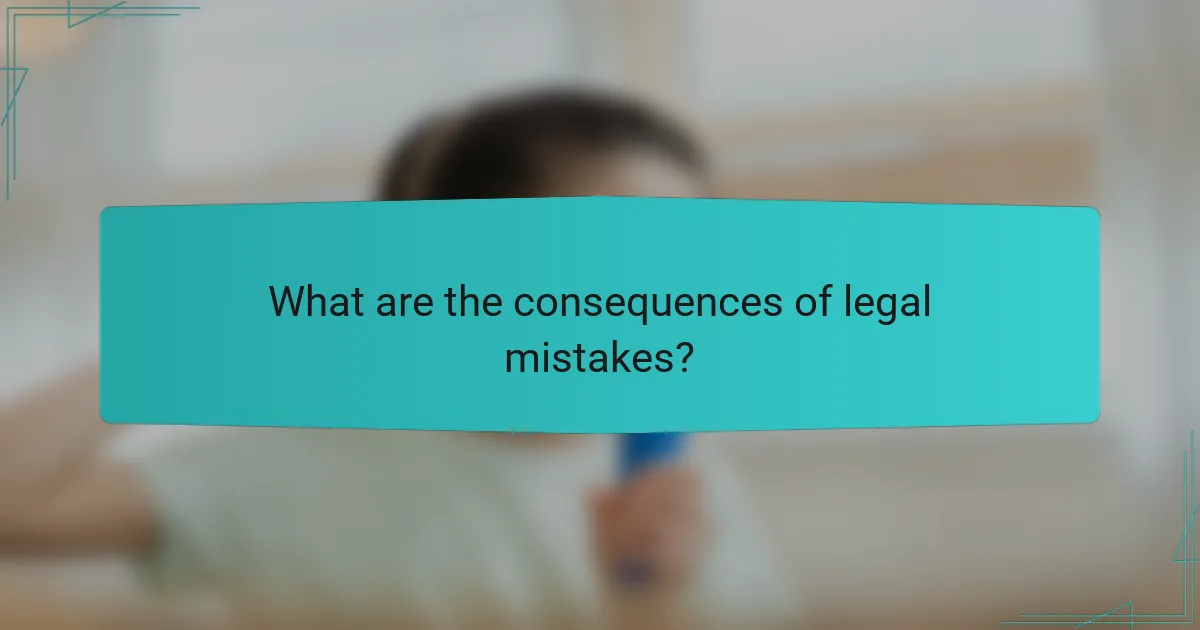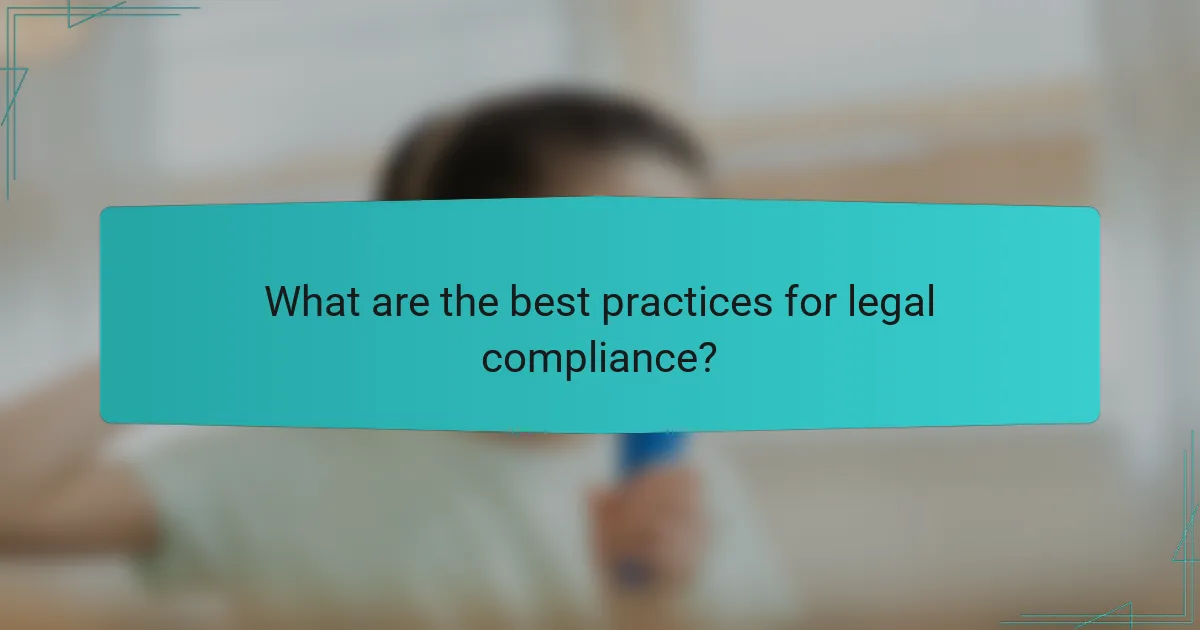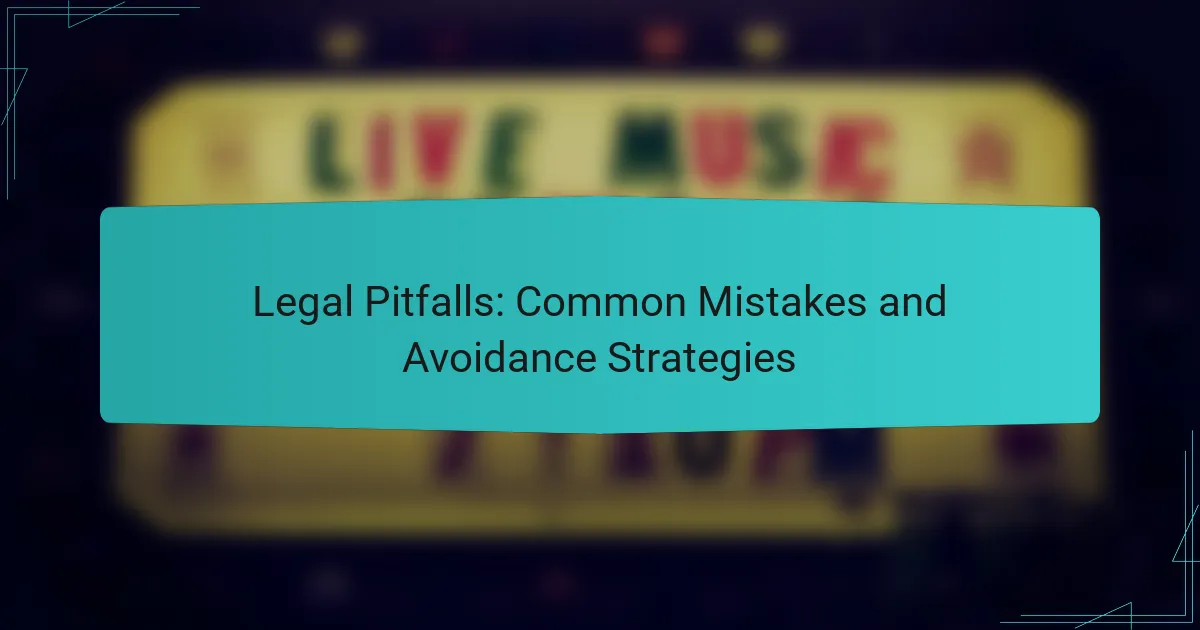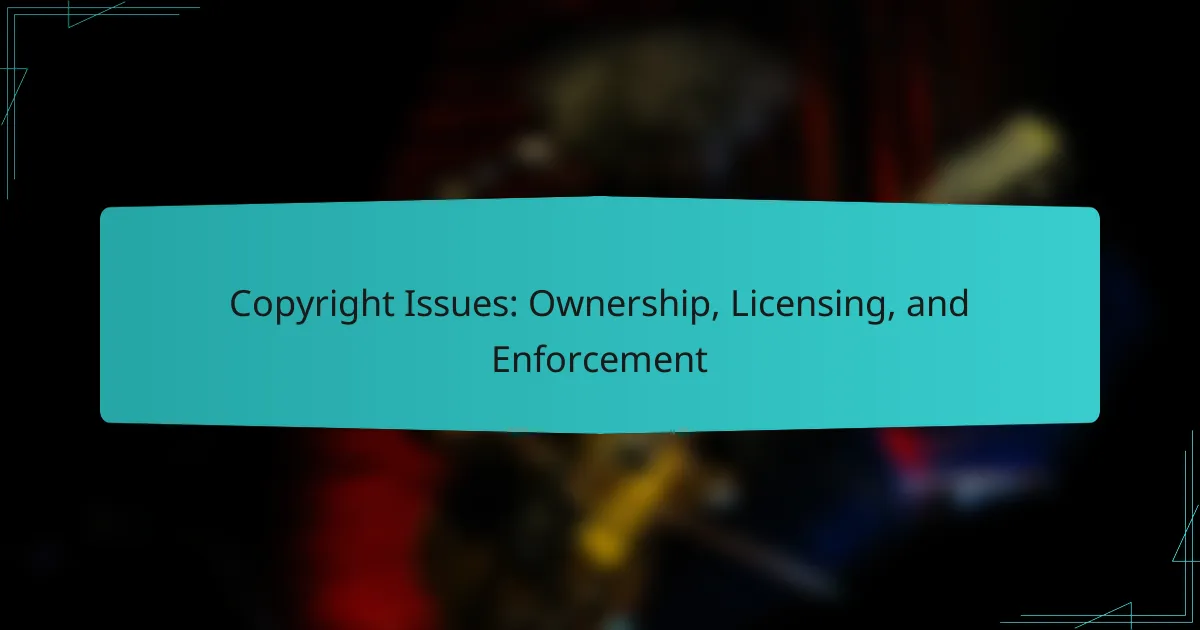Navigating the legal landscape is crucial for businesses, especially in the realm of digital products, where common pitfalls such as intellectual property infringement and data protection non-compliance can arise. By recognizing these challenges and implementing proactive strategies, organizations can safeguard themselves against costly legal disputes and maintain regulatory compliance. Understanding the potential repercussions of legal mistakes is essential for mitigating risks and ensuring long-term success.

What are the common legal pitfalls in digital products?
Common legal pitfalls in digital products include issues like intellectual property infringement, non-compliance with data protection laws, and misleading advertising practices. Understanding these pitfalls can help businesses avoid costly legal disputes and maintain compliance with regulations.
Intellectual property infringement
Intellectual property infringement occurs when a digital product uses copyrighted material, trademarks, or patents without permission. This can lead to lawsuits and significant financial penalties. To avoid this, ensure that all content, images, and software used in your product are either original, licensed, or fall under fair use.
Conduct regular audits of your digital assets to confirm compliance with intellectual property laws. For instance, using stock images requires proper licensing, and failing to do so can result in legal action.
Non-compliance with data protection laws
Non-compliance with data protection laws, such as the GDPR in Europe or CCPA in California, can result in hefty fines and reputational damage. Businesses must ensure they collect, store, and process personal data in accordance with these regulations. This includes obtaining user consent and providing clear privacy policies.
Regularly review your data handling practices and update your privacy policy to reflect current laws. Implementing data protection measures, such as encryption and access controls, can also help mitigate risks.
Misleading advertising practices
Misleading advertising practices involve making false or exaggerated claims about a product’s features or benefits. This can lead to legal challenges and loss of consumer trust. To avoid this, ensure that all marketing materials are truthful and substantiated by evidence.
Consider conducting market research to validate claims before publishing advertisements. Transparency in your messaging can enhance credibility and reduce the risk of legal repercussions.
Failure to secure user consent
Failure to secure user consent can lead to violations of privacy laws and loss of user trust. It is essential to obtain explicit consent from users before collecting or processing their personal data. This includes providing clear options for users to agree or opt-out.
Implementing double opt-in processes for email subscriptions and clear consent forms for data collection can help ensure compliance. Regularly review consent practices to align with evolving regulations.
Neglecting terms of service agreements
Neglecting terms of service agreements can expose businesses to legal risks and disputes. These agreements outline the rules and guidelines for using a digital product, and failing to have one can lead to misunderstandings with users. It is crucial to create comprehensive terms of service that cover liability, user rights, and acceptable use policies.
Regularly update your terms of service to reflect changes in your business model or legal requirements. Make the agreement easily accessible to users, and consider requiring users to acknowledge acceptance before using your product.

How can businesses avoid legal pitfalls?
Businesses can avoid legal pitfalls by proactively implementing strategies that address compliance, user agreements, and employee training. By focusing on thorough audits, engaging legal counsel, and developing clear policies, companies can significantly reduce their risk of legal issues.
Implement comprehensive legal audits
Conducting comprehensive legal audits helps businesses identify potential compliance gaps and legal vulnerabilities. These audits should cover various aspects such as contracts, employment practices, and regulatory compliance to ensure all areas are addressed.
Regular audits, ideally on an annual basis, can help pinpoint issues before they escalate into significant problems. Consider using a checklist that includes reviewing contracts, assessing compliance with local laws, and evaluating risk management strategies.
Engage legal counsel for compliance
Engaging legal counsel is crucial for ensuring compliance with applicable laws and regulations. A qualified attorney can provide guidance on industry-specific regulations, helping businesses navigate complex legal landscapes.
Establish a relationship with a legal expert who understands your business model and industry. This can help you stay updated on changes in laws and regulations, and ensure that your practices align with legal requirements.
Develop clear user agreements
Clear user agreements are essential for protecting businesses from legal disputes. These agreements should outline the terms of service, privacy policies, and user responsibilities in straightforward language.
Ensure that user agreements are easily accessible and that users actively consent to them. Regularly review and update these documents to reflect changes in laws or business practices, minimizing the risk of misunderstandings or legal challenges.
Conduct regular training on legal issues
Regular training on legal issues is vital for keeping employees informed about compliance and legal responsibilities. Training sessions should cover topics such as data protection, workplace policies, and ethical standards.
Consider implementing quarterly training programs and using real-life scenarios to illustrate potential legal pitfalls. This proactive approach can empower employees to recognize and address legal issues before they escalate, fostering a culture of compliance within the organization.

What are the consequences of legal mistakes?
Legal mistakes can lead to significant repercussions, including financial losses, damage to reputation, and prolonged legal disputes. Understanding these consequences is crucial for individuals and businesses to mitigate risks and avoid pitfalls.
Financial penalties
Financial penalties are among the most immediate consequences of legal mistakes. These can include fines, restitution, or damages awarded in lawsuits, which can range from hundreds to millions of dollars depending on the severity of the violation. For example, a business found in violation of labor laws may face fines that significantly impact its bottom line.
To avoid financial penalties, it is essential to stay informed about relevant laws and regulations. Regular compliance audits and legal consultations can help identify potential issues before they escalate into costly mistakes.
Reputational damage
Reputational damage occurs when legal mistakes become public knowledge, leading to loss of trust among customers, clients, and partners. This can result in decreased sales, loss of business opportunities, and a tarnished brand image. For instance, companies involved in fraud or unethical practices often see a sharp decline in customer loyalty.
To protect reputation, businesses should prioritize transparency and ethical practices. Implementing a robust internal compliance program can help prevent legal issues and demonstrate commitment to ethical standards.
Legal disputes and litigation
Legal disputes and litigation can arise from legal mistakes, resulting in lengthy and costly court battles. These disputes can drain resources, divert attention from core business activities, and create uncertainty. For example, a contract dispute may lead to litigation that lasts several months or even years.
To minimize the risk of litigation, clear and thorough documentation is essential. Businesses should ensure contracts are well-drafted and reviewed by legal professionals to avoid ambiguities that could lead to disputes. Additionally, considering alternative dispute resolution methods, such as mediation, can provide a quicker and less expensive resolution to conflicts.

What are the best practices for legal compliance?
Best practices for legal compliance involve regularly reviewing and updating policies, staying informed about legislative changes, and utilizing effective compliance management tools. These strategies help organizations minimize legal risks and ensure adherence to applicable laws and regulations.
Regularly update privacy policies
Regular updates to privacy policies are essential to reflect current practices and legal requirements. Organizations should review their policies at least annually or whenever significant changes occur, such as new data collection methods or changes in applicable laws.
Ensure that privacy policies are clear and accessible to users. Use straightforward language to explain how personal data is collected, used, and protected. This transparency builds trust and helps avoid potential legal issues.
Monitor changes in legislation
Monitoring changes in legislation is crucial for maintaining legal compliance. Organizations should designate a team or individual responsible for tracking relevant laws, regulations, and industry standards that may impact their operations.
Consider subscribing to legal updates or utilizing services that provide alerts on legislative changes. This proactive approach allows organizations to adapt quickly and avoid penalties associated with non-compliance.
Utilize compliance management tools
Compliance management tools streamline the process of ensuring adherence to legal requirements. These tools can help organizations track compliance status, manage documentation, and automate reporting processes.
When selecting compliance management software, look for features that align with your specific needs, such as risk assessment capabilities, audit trails, and integration with existing systems. This investment can save time and reduce the likelihood of costly compliance errors.

What frameworks can guide legal decision-making?
Several frameworks can assist in legal decision-making by providing structured approaches to evaluate risks and ensure compliance. Utilizing these frameworks helps organizations navigate complex legal landscapes and avoid common pitfalls.
Risk assessment frameworks
Risk assessment frameworks help identify, evaluate, and prioritize potential legal risks within an organization. Common frameworks include the ISO 31000 standard, which provides guidelines for risk management, and the COSO framework, focusing on enterprise risk management. These frameworks encourage organizations to assess the likelihood and impact of risks, allowing for informed decision-making.
When implementing a risk assessment framework, consider conducting regular reviews and updates to reflect changes in regulations or business operations. For example, a company might assess risks related to data privacy laws, such as the GDPR in Europe, and adjust its policies accordingly to mitigate potential legal issues.
Legal compliance checklists
Legal compliance checklists serve as practical tools to ensure adherence to relevant laws and regulations. These checklists can cover various areas, including employment law, environmental regulations, and data protection. By systematically reviewing compliance requirements, organizations can identify gaps and take corrective actions before issues arise.
To create an effective compliance checklist, start by listing applicable laws and regulations, then outline specific actions needed to meet those requirements. For instance, a checklist for GDPR compliance might include steps like obtaining user consent, implementing data protection measures, and conducting regular audits. Regularly updating the checklist is crucial to accommodate new legal developments.

How does jurisdiction affect legal strategies?
Jurisdiction significantly impacts legal strategies by determining which laws apply and where legal actions can be pursued. Understanding jurisdiction helps in choosing the right venue for litigation and in anticipating the legal landscape that will shape the case.
Types of Jurisdiction
Jurisdiction can be categorized into several types, including personal, subject matter, and territorial jurisdiction. Personal jurisdiction refers to a court’s authority over the parties involved, while subject matter jurisdiction pertains to the court’s authority to hear a particular type of case. Territorial jurisdiction is about the geographical area where a court can exercise its authority.
For example, a state court in California may have personal jurisdiction over a defendant residing in California but not over someone living in New York. Understanding these distinctions is crucial for effective legal strategy.
Choosing the Right Jurisdiction
Selecting the appropriate jurisdiction can influence the outcome of a case. Factors to consider include the location of the parties, the nature of the dispute, and the applicable laws. For instance, some jurisdictions may have more favorable laws for certain types of claims, such as torts or contracts.
Legal professionals often analyze the potential advantages and disadvantages of different jurisdictions, which may include varying statutes of limitations or procedural rules. This analysis can guide where to file a lawsuit or how to structure a settlement negotiation.
Common Jurisdictional Pitfalls
One common pitfall is failing to establish proper jurisdiction before filing a case, which can lead to dismissal. Another mistake is underestimating the impact of jurisdiction on the enforceability of judgments. For example, a judgment obtained in one state may not be enforceable in another without proper jurisdictional considerations.
To avoid these pitfalls, always verify the jurisdictional requirements relevant to your case. Consulting with a legal expert familiar with the specific jurisdiction can provide clarity and help navigate complex legal waters.



